
HPR109F, Spring 2002
Answers to Midterm exam, Thursday 7 March
Chapters 1–8
Definitions (2 points each; 20
points total)
1. Positive feedback loop—A loop with
an even number of negative couplings (including zero). It tends to amplify the
effect of disturbances.
2. Albedo—The fraction of the
incident radiation reflected by a surface.
3. Low-velocity zone—The vertical
region of slower seismic waves at the top of the asthenosphere. It is caused by
a small amount of molten rock.
4. Stratosphere—The layer of
atmosphere directly above the troposphere. It is where the ozone layer is found.
5. Stable equilibrium—A state to
which a system will tend to return after being disturbed.
6. Coriolis effect—The apparent
rightward force on moving air or water in the Northern Hemisphere. The Coriolis
effect is independent of the direction of motion.
7. Thermohaline conveyor belt—The 3-D
oceanic circulation that is driven by differences in density that originate in
differences in T or S.
8. Ekman spiral—The progressive
rightward angle of near-surface ocean currents with depth in the surface layer.
9. Heavy bombardment period—The first
700 or 800 million years of earth history, during which the surface was struck
frequently by large meteors, comets, and asteroids.
10. Biological pump—The sinking of
dead organisms and fecal matter from the surface layer to the deep ocean. It
transfers organic matter and nutrients efficiently to deep water.
Short answers (3 points each; 30
points total)
1. How has atmospheric CO2
varied since 1800? Use a diagram if you wish. It began to rise slowly in the
1800s as American settlers cleared forest for agriculture (the pioneer effect).
It then rose a little faster after about 1850 (the beginning of the industrial
age), and accelerated around 1950. Regular annual cycles are superimposed on
these longer-term trends.
2. Explain the “faint young sun” paradox and offer a possible resolution for it. Even though the sun was about 30% fainter when the earth was young, the earth was not correspondingly cooler then. There was probably a lot more carbon dioxide in the early atmosphere to keep it warm.
3. What is currently the most important greenhouse gas on earth? Water vapor. Carbon dioxide, the usual suspect, actually comes in a distant second.
4. Briefly describe a typical ice-age cycle as revealed by the Vostok ice core. Use a diagram. A typical cycle lasts for 100,000–120,000 years, with about 80% being in the cold glacial phase and 20% in the warmer interglacial phase. The glacial is about 6ºC–8ºC colder than the interglacial. The cycle is shaped like an asymmetric sawtooth, with a rapid rise into the interglacial and a slower descent into the glacial. There are brief periods of intermediate warming during the glacial phase.
5. How might it be possible to have ice sheets on continents assembled at the equator, such as appears to have been the case during the Late Proterozoic Period? The rapid silicate weathering (due to the warm temperatures and high humidities) drew down so much carbon dioxide that the earth cooled enough to glaciate even the tropical continents.
6. How and where is dense bottom water formed? Formed near Greenland/Iceland and the Weddell Sea, where the cold air create polar ice sheets that exclude sea salt from their matrix. The cold, salty water is very dense.
7. The earth’s atmosphere contains 10 Gt of methane. About 0.5 Gt enters and leaves each year at steady state. What is the residence time of methane in the atmosphere? Can it move between hemispheres before being removed, and why? 20 years (10 Gt divided by 0.6 Gt y-1) It can easily move between the hemispheres because that requires only 1–2 years.
8. In the southern side of the North Atlantic and North Pacific gyres the trade winds blow toward the southwest but the ocean currents move straight to the west. Why? Use a diagram if it helps. Because it is deflected to the right of the wind force by the Coriolis force:

9. List the four sources of heat for the earth’s core. Which are most
important? Potential energy release during accretion, kinetic energy of
bombarding objects, radioactivity, and potential energy released as the dense
iron and nickel sank to form the core. The first two were probably the more
important.
10. Explain how the potential energy in
cold, dry northern air masses is converted to the kinetic energy of storms
(low-pressure centers that form along the polar front). The cold, dry
northern air is originally separated from the warm, moist southern air by
something like a vertical wall (the polar front). This is an unstable situation
because the northern air is denser than the southern air. Something disturbs the
bottom of this wall and allows the northern air to flow under the southern air,
releasing potential energy (lowering the center of gravity of the system) that
then appears as the kinetic energy of the storm.
Problems and longer answers (10
points each; 50 points total)
1. Planet X receives a flux of 100 units
of solar radiation and has an albedo of 50%. Its atmosphere is like Earth’s.
Draw a diagram showing how its greenhouse effect works.
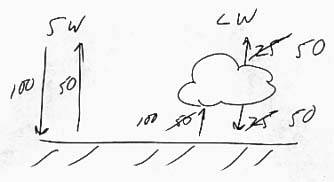
2. Planet Y has a solar constant S = 2000 W m-2 at the edge of its atmosphere and an albedo of 20%. Given the Stefan-Boltzmann constant of s = 5.67 x 10-8 W m-2 K-4, calculate the equilibrium temperature of its surface in the absence of a greenhouse effect. If you are unsure of the formula to use, derive it.
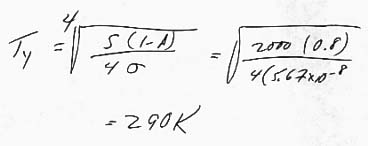
3. Use diagrams to derive the earth’s three-celled atmospheric circulation. Why don’t one cell and two cells work?
One-celled system
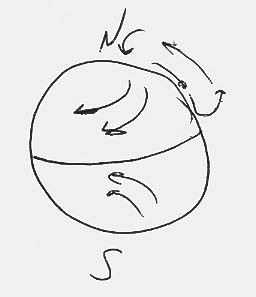
One-celled motion doesn't work because it produces westward motion over the entire globe. This would frictionally slow down the earth's speed of rotation. But photons from the sun cannot do this, because half would tend to speed up the earth.
Two-celled system
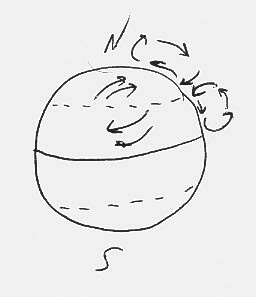
Two-celled motion can balance the frictional force, but creates upward-moving air at the poles.
Three-celled system
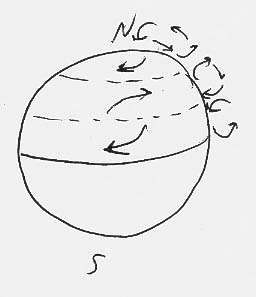
Three-celled motion can satisfy both the need for zero net friction and air rising and falling at the proper latitudes.
4. Draw the simple feedback loop between the earth’s surface temperature and its infrared radiation outwards. Is it positive or negative, and why? What is its role relative to other important feedback loops we have encountered, such as those involving temperature, ice sheets, and albedo on the one hand and temperature, water vapor, and the greenhouse effect on the other? The loop is negative because it contains a single negative coupling. Its role is to stabilize the other major feedback loops, which are mostly positive.

5. It is said that drifting continents and plate tectonics are the surface expressions of heat escaping from the core of the earth. Describe the chain of influences inside the earth that lead to plate tectonics (drifting continents). Start from the core, progress up through the mantle, and into the asthenosphere and lithosphere. Use a diagram if it will help.
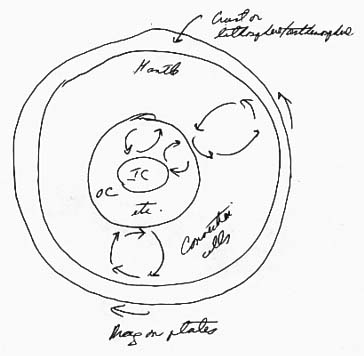
The heat escaping from the solid inner core (IC) sets up "vertical" convection cells in the liquid outer core (OC). That carries heat to the bottom of the mantle, where it in turn sets up convection cells throughout the mantle, either in one thick layer or in two smaller ones. The top of those cells moves horizontally along the bottom of the asthenosphere and drags the plates with it, creating drifting continents and plate tectonics. Thus plate tectonics is ultimately the surface expression of heat escaping from the core.